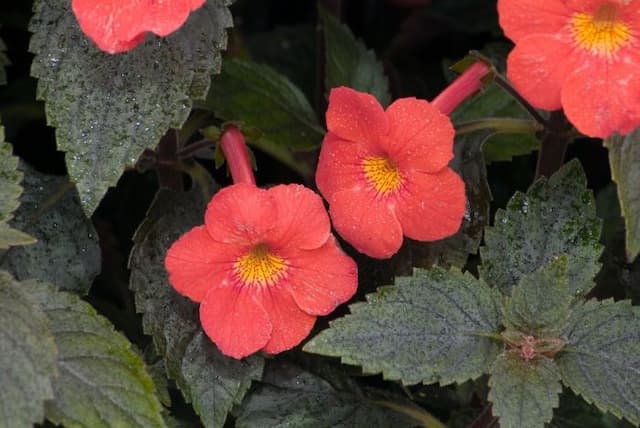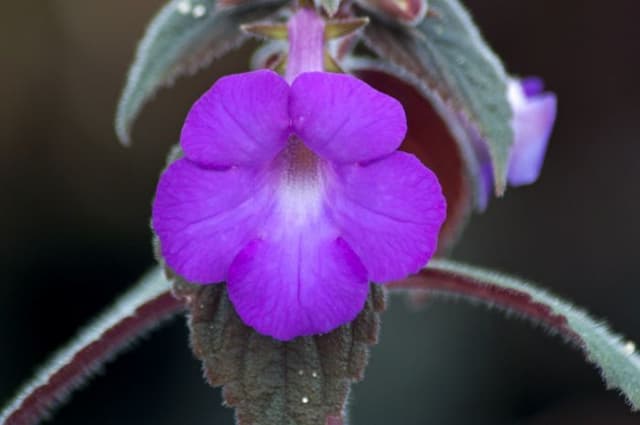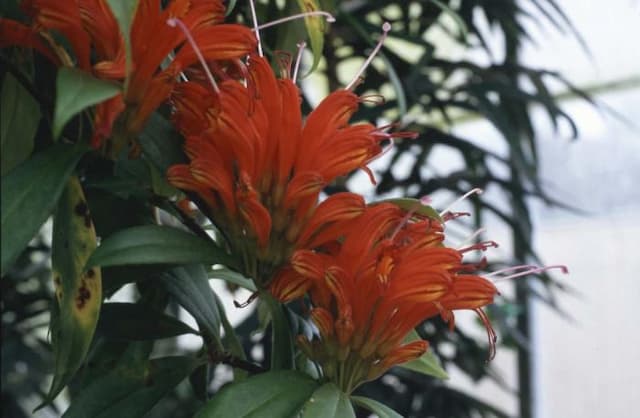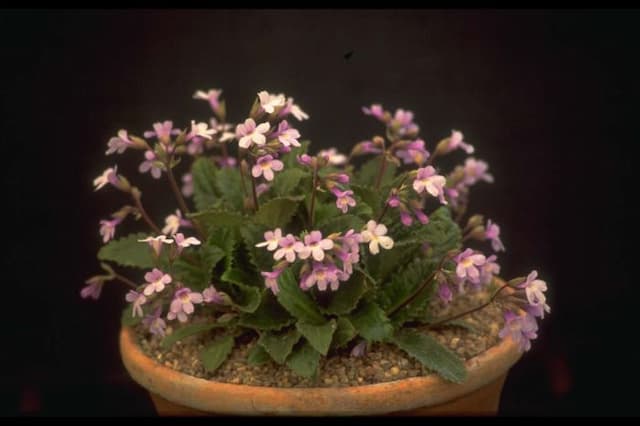Cape primrose Streptocarpus 'Frosty Diamond'

ABOUT
Streptocarpus 'Frosty Diamond', often known as Cape Primrose, exhibits a stunning display with its distinctive foliage and flowers. The leaves of this plant are typically lush and velvety, creating a rosette pattern as they emerge from the base. Their color ranges from deep green to occasionally having a slightly silvery sheen, which serves as an elegant backdrop to the blossoms. The flowers of Cape Primrose 'Frosty Diamond' are its most striking feature. They are characterized by their white petals overlaid with a delicate network of fine, frosty-looking markings, giving them a dusted appearance as if sprinkled with diamond dust. Each bloom is shaped like a trumpet or funnel, with a gentle flaring at the mouth, and they grow in clusters on slender stems that rise above the foliage, adding a touch of gracefulness to the plant's overall appearance. Cape Primrose is appreciated for its ornate blooms and the contrasting plush leaves, making it a beloved choice for indoor plant enthusiasts and collectors who enjoy its opulent yet delicate beauty.
About this plant
 Names
NamesFamily
Gesneriaceae
Synonyms
Cape Primrose, African Violet Cousin
Common names
Streptocarpus 'Frosty Diamond'
 Toxicity
ToxicityTo humans
The Cape Primrose (Streptocarpus 'Frosty Diamond') is generally considered non-toxic to humans. Hence, ingesting parts of this plant is unlikely to cause serious poisoning or adverse symptoms. However, it is still advisable to avoid eating ornamental plants as they are not intended for consumption, and individual reactions can vary.
To pets
The Cape Primrose (Streptocarpus 'Frosty Diamond') is generally not toxic to pets such as cats and dogs. If a pet ingests part of this plant, it is not expected to show serious symptoms of poisoning. Nevertheless, as with any non-food plant, ingestion might sometimes result in mild gastrointestinal upset due to the ingestion of non-digestible matter.
 Characteristics
CharacteristicsLife cycle
Perennials
Foliage type
Evergreen
Color of leaves
Green
Flower color
White
Height
0.5 feet (15 cm)
Spread
0.5 feet (15 cm)
Plant type
Herb
Hardiness zones
10
Native area
South Africa
Benefits
 General Benefits
General Benefits- Easy Care: Streptocarpus 'Frosty Diamond' is known for being low-maintenance, making it suitable for busy individuals or those new to gardening.
- Attractive Blooms: The plant produces beautiful white blooms with a unique frosty appearance that can add aesthetic value to any indoor space.
- Long Flowering Season: It has a long blooming period which ensures that the plant remains decorative with flowers for extended periods.
- Compact Size: Its compact growth habit makes it ideal for limited spaces like apartments and small offices.
- Tolerant to Low Light: This variety can tolerate lower light conditions better than many flowering plants, therefore can be placed in less sunny spots.
- Non-toxic: Streptocarpus plants are generally non-toxic, making them safe for households with pets and children.
 Medical Properties
Medical PropertiesThis plant is not used for medical purposes.
 Air-purifying Qualities
Air-purifying QualitiesThis plant is not specifically known for air purifying qualities.
 Other Uses
Other Uses- Photography Subjects: Streptocarpus 'Frosty Diamond' has unique, visually striking flowers that can serve as an excellent subject for macro photography, capturing the delicate patterns and colors.
- Edible Garnish: While not commonly consumed, the petals of Streptocarpus 'Frosty Diamond' can be used as a decorative, edible garnish for salads and desserts, provided they are free of pesticides.
- Art Inspiration: The intricate patterns of Frosty Diamond flowers can inspire artists and designers for patterns in textiles, wallpaper, or other decorative artwork.
- Teaching Tool: Frosty Diamond can be used in educational settings to teach students about plant hybridization, morphology, and growth habits.
- Color Dye: The pigments from the flowers can sometimes be used as a natural color dye for fabrics or art projects.
- Gift Plant: Due to its showy flowers and manageable size, Frosty Diamond makes an excellent gift for plant enthusiasts and gardeners.
- Space Beautification: This plant can be used to beautify small spaces such as office desks or window sills with its compact growth and ornate flowers.
- Companion Planting: Frosty Diamond can be paired with other shade-loving plants in a container garden, creating a diverse and aesthetically pleasing arrangement.
- Crafting: Dried flowers of Streptocarpus 'Frosty Diamond' can be used in crafting, for example, in making bookmarks, greeting cards, or pressed flower arrangements.
- Seasonal Decorations: The frosty appearance of its flowers can complement winter or holiday-themed decor in floral arrangements or table centerpieces.
Interesting Facts
 Feng Shui
Feng ShuiThe Cape Primrose is not used in Feng Shui practice.
 Zodiac Sign Compitability
Zodiac Sign CompitabilityThe Cape Primrose is not used in astrology practice.
 Plant Symbolism
Plant Symbolism- Resilience: Streptocarpus, commonly known as Cape Primrose, often symbolizes resilience because it can survive in shady and challenging environments, coming back strong after perceived dormancy.
- Enduring Love: The long blooming period of Cape Primrose is emblematic of enduring love, showing that affection and beauty can persist through time.
- Adaptability: The plant's ability to adapt to different light conditions is indicative of flexibility and adaptability in life's circumstances.
- New Beginnings: Cape Primrose's regular growth cycle can symbolize new beginnings, representing the constant opportunity for renewal and growth.
 Water
WaterCape primrose should be watered when the top inch of soil feels dry to the touch, which will typically be once a week, but this can vary depending on environmental conditions. It's better to err on the side of underwatering rather than overwatering, as Cape primrose does not like to sit in waterlogged soil. When watering, gently pour water at the base of the plant until it begins to drain from the bottom of the pot. Depending on the size of the pot, this might be around 8 to 16 ounces for smaller pots and up to a gallon for larger ones, but always make sure excess water is able to drain away to avoid root rot.
 Light
LightCape primrose thrives in bright, indirect light. Placing it near an east or north-facing window where it can receive a few hours of gentle morning sunlight or late afternoon light is ideal. Avoid direct midday sun, as it can scorch the leaves of the plant. If natural light is limited, fluorescent grow lights also work well for Cape primrose.
 Temperature
TemperatureCape primrose prefers temperatures between 60 and 75 degrees Fahrenheit, with a minimum of 50 degrees to avoid cold damage and a maximum of 80 degrees to prevent heat stress. The ideal conditions include consistently warm temperatures without significant fluctuations, so avoid placing the plant near drafts or heat sources that could cause sudden temperature changes.
 Pruning
PruningPrune Cape primrose regularly to remove spent flowers and encourage bushier growth. Deadheading, or the removal of faded blooms, should be done as needed to keep the plant looking tidy and to promote further flowering. Best done after the main flowering flush, additional light pruning can be carried out to shape the plant and manage its size.
 Cleaning
CleaningAs needed
 Soil
SoilThe Cape Primrose requires a well-draining soil mix, ideally composed of peat moss, perlite, and vermiculite, in a ratio of 2:1:1. These plants thrive in slightly acidic to neutral soil, aiming for a pH range between 5.8 and 7.0 for optimal growth and flowering.
 Repotting
RepottingCape Primroses should be repotted annually to refresh the soil and accommodate root growth. It is best to repot in spring or early summer before the growth season peaks, ensuring they have room to thrive each year.
 Humidity & Misting
Humidity & MistingCape Primroses prefer a moderate to high humidity level, ideally around 50-60%. Keeping them in a well-humidified room or using a humidity tray can create the right environment for healthy growth without the need for frequent watering.
 Suitable locations
Suitable locationsIndoor
Place in bright, indirect light and keep moist.
Outdoor
Only in warm, frost-free climates, shaded area.
Hardiness zone
10-11 USDA.
 Life cycle
Life cycleCape Primrose 'Frosty Diamond' begins its life cycle as a seed, which, when sown in a well-draining soil mix and kept warm and moist, will germinate. The seedling emerges with a set of initial leaves and, over time, develops into a young plant with characteristic fuzzy foliage. As the plant matures, it produces larger leaves and starts to form flower stalks; each stalk may bear multiple blossoms known for their velvety texture and white color with speckled variegation. Following the flowering stage, the plant can produce capsules that contain seeds, completing its reproductive cycle. Vegetatively, Cape Primrose 'Frosty Diamond' can also propagate through leaf cuttings, where a leaf or a portion of it is used to grow a new plant. Over time, the plant will experience a period of dormancy, typically in the winter months, where growth slows before resuming in the spring.
 Propogation
PropogationPropogation time
Spring-Early Summer
The Streptocarpus 'Frosty Diamond', commonly known as Cape Primrose, can be propagated most effectively through leaf cuttings, a popular method utilized by enthusiasts of this plant. To propagate by leaf cuttings, select a healthy, mature leaf and cut it across horizontally; smaller leaves can be used whole. Then, insert the cut end into a moist, well-draining potting mix. Keep the potting soil consistently moist and place the pot in a warm, bright area without direct sunlight, which may scorch the delicate cuttings. In a matter of weeks, small plantlets should begin to appear at the base of the cutting. Once these plantlets have grown to a reasonable size, typically a few inches in height, they can be gently separated and potted individually to grow on as new Cape Primrose plants.









